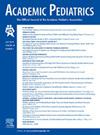The Association Between Adverse Childhood Experiences and Health–Related School Absenteeism: Results From a National Survey of Youth
IF 2.8
3区 医学
Q1 PEDIATRICS
引用次数: 0
Abstract
Objective
Adverse childhood experiences (ACEs) and school absenteeism are both linked to poor health and educational outcomes. However, little is known about whether ACEs contribute to school absenteeism for health reasons. We examined the association between ACEs and health–related school absenteeism in a nationally representative sample.
Methods
This cross-sectional study used data from the 2021 to 2022 National Health Interview Survey. Parents of participants reported on 7 ACEs and missed school days in the past 12 months due to illness, injury, or disability (“health-related absences”). Weighted logistic regressions tested whether exposure to ACEs was associated with any health-related absences as well as health–related chronic absenteeism (defined as missing at least 10% of school days), adjusting for covariates. We then tested whether general health status mediated the relationship between ACEs and absenteeism.
Results
The unweighted sample included 10,794 youth ages 6 to 17. One quarter (24.3%) reported 1 or more ACE, and participants had 3.24 health-related absences on average. Exposure to at least 1 ACE was associated with increased odds of health-related absenteeism (Adjusted Odds Ratio (AOR) 1.53, 95% Confidence Interval (CI) 1.35–1.73) and health–related chronic absenteeism (AOR 2.43, 95% CI 1.80–3.28). General health status accounted for 6.9% of the relationship between ACEs and any health-related absenteeism and 13.1% of the relationship between ACEs and health–related chronic absenteeism (P < .001).
Conclusions
ACEs are associated with health-related absenteeism, and this association is partially mediated by general health status. Health systems and schools might focus jointly on preventing and mitigating the health and life course risks associated with both ACEs and absenteeism.
ace与健康相关缺勤之间的关系:来自全国青少年调查的结果。
目的:不良的童年经历(ace)和学校缺勤都与不良的健康和教育成果有关。然而,人们对ace是否会导致因健康原因而缺课知之甚少。我们在一个具有全国代表性的样本中检验了ace与健康相关的学校缺勤之间的关系。方法:本横断面研究使用了2021-2022年全国健康访谈调查的数据。参与者的父母报告说,在过去12个月里,由于生病、受伤或残疾(“与健康有关的缺课”),有7次ace和缺课日。加权逻辑回归检验了暴露于ace是否与任何与健康相关的缺课以及与健康相关的慢性缺课(定义为缺课至少10%)有关,并对协变量进行了调整。然后,我们测试了一般健康状况是否介导了ace与缺勤之间的关系。结果:未加权样本包括10794名6-17岁的青少年。四分之一(24.3%)报告了一次或多次ACE,参与者平均有3.24次与健康相关的缺勤。暴露于至少一种ACE与健康相关缺勤(AOR 1.53, 95% CI 1.35-1.73)和健康相关慢性缺勤(AOR 2.43, 95% CI 1.80-3.28)的几率增加相关。一般健康状况在不良经历与健康相关缺勤之间的关系中占6.9%,在不良经历与健康相关慢性缺勤之间的关系中占13.1%(结论:不良经历与健康相关缺勤相关,且这种关联部分由一般健康状况介导。卫生系统和学校可以共同关注预防和减轻与ace和缺勤相关的健康和生命过程风险。
本文章由计算机程序翻译,如有差异,请以英文原文为准。
求助全文
约1分钟内获得全文
求助全文
来源期刊

Academic Pediatrics
PEDIATRICS-
CiteScore
4.60
自引率
12.90%
发文量
300
审稿时长
60 days
期刊介绍:
Academic Pediatrics, the official journal of the Academic Pediatric Association, is a peer-reviewed publication whose purpose is to strengthen the research and educational base of academic general pediatrics. The journal provides leadership in pediatric education, research, patient care and advocacy. Content areas include pediatric education, emergency medicine, injury, abuse, behavioral pediatrics, holistic medicine, child health services and health policy,and the environment. The journal provides an active forum for the presentation of pediatric educational research in diverse settings, involving medical students, residents, fellows, and practicing professionals. The journal also emphasizes important research relating to the quality of child health care, health care policy, and the organization of child health services. It also includes systematic reviews of primary care interventions and important methodologic papers to aid research in child health and education.
 求助内容:
求助内容: 应助结果提醒方式:
应助结果提醒方式:


